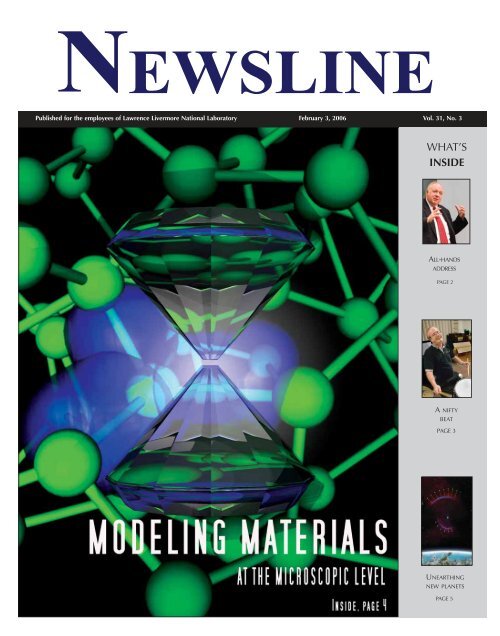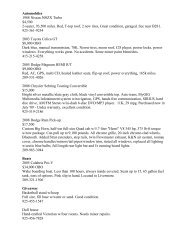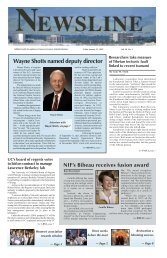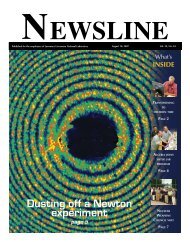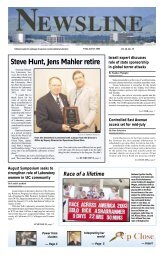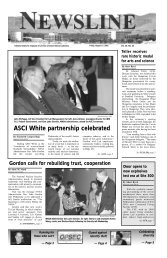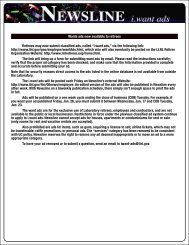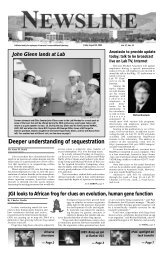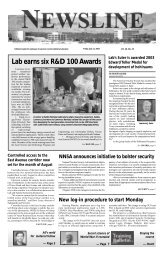what's inside - NEWSLINE - Lawrence Livermore National Laboratory
what's inside - NEWSLINE - Lawrence Livermore National Laboratory
what's inside - NEWSLINE - Lawrence Livermore National Laboratory
You also want an ePaper? Increase the reach of your titles
YUMPU automatically turns print PDFs into web optimized ePapers that Google loves.
<strong>NEWSLINE</strong><br />
Published for the employees of <strong>Lawrence</strong> <strong>Livermore</strong> <strong>National</strong> <strong>Laboratory</strong> February 3, 2006 Vol. 31, No. 3<br />
WHAT’S<br />
INSIDE<br />
ALL-HANDS<br />
ADDRESS<br />
PAGE 2<br />
A NIFTY<br />
BEAT<br />
PAGE 3<br />
UNEARTHING<br />
NEW PLANETS<br />
PAGE 5
2<br />
Newsline<br />
VIP VISITS<br />
Scowcroft leads discussion of WMD<br />
Brent Scowcroft (at right), chaired a<br />
VIP roundtable discussion, “Unclear and<br />
Present Danger: Understanding and<br />
Responding to WMD Latency and Related<br />
Destructive Potential Emerging in<br />
Contemporary Societies” presented<br />
recently by the Lab’s Center for Global<br />
Security Research (CGSR).<br />
Scowcroft was the <strong>National</strong> Security<br />
Adviser under presidents Gerald Ford and<br />
George H. W. Bush and a lieutenant general<br />
in the US Air Force. He also served as<br />
military assistant to President Richard<br />
Nixon and as deputy assistant to the president<br />
for <strong>National</strong> Security Affairs in the<br />
Nixon and Ford administrations. He also<br />
served as chairman of the President’s<br />
Foreign Intelligence Advisory Board under<br />
Feb. 3, 2006<br />
Brooks sees weapons program transformation<br />
In an all-hands meeting at the<br />
Lab Thursday, <strong>National</strong> Nuclear<br />
Security Administration<br />
Administrator Linton Brooks discussed<br />
the future of the weapons<br />
program, <strong>Livermore</strong> contract competition<br />
and provided his view of<br />
the long-term future for national<br />
security programs.<br />
Acknowledging the “uncertainty”<br />
of the times, Brooks sought to<br />
reassure employees about the future<br />
of the <strong>Laboratory</strong> in “preemptive”<br />
opening remarks before fielding<br />
questions from the audience in the<br />
Bldg. 123 auditorium.<br />
Addressing NNSA’s core mission,<br />
Brooks said the nuclear<br />
weapons programs may be “on the<br />
verge of a transformation” with a<br />
new vision for the nation’s nuclear<br />
deterrent.<br />
The Reliable Replacement<br />
Warhead (RRW) effort will take the<br />
nuclear weapons program in a new<br />
direction, much as science-based<br />
stockpile stewardship transformed<br />
the nuclear weapons complex 10<br />
years ago, he said.<br />
“RRW offers an enormously<br />
compelling vision that now has to<br />
be turned into reality,” Brooks said,<br />
noting that many people were skeptical<br />
that stockpile stewardship<br />
could achieve its ambitious goals.<br />
“Today everybody recognizes<br />
that stockpile stewardship is the<br />
only way to think about nuclear<br />
weapons. SSP was clearly the right<br />
thing to do.”<br />
Brooks described the RRW<br />
vision as a world with a much<br />
smaller nuclear stockpile requiring<br />
less cumbersome routine maintenance<br />
procedures and a better integrated<br />
weapons complex.<br />
The capabilities developed by<br />
SSP, such as advanced simulation,<br />
have laid the foundation for developing<br />
the RRW, according to<br />
Brooks. “We can take a sophisticated<br />
design and develop it without<br />
testing. That wouldn’t have been<br />
possible 10 years ago.”<br />
Linton Brooks<br />
President George W. Bush from 2001 to<br />
2005.<br />
In the course of his military career, Scowcroft<br />
held positions in the Organization of the Joint<br />
Chiefs of Staff, Headquarters of the U.S. Air<br />
Force and the Office of the Assistant Secretary of<br />
Defense for International Security Affairs. Other<br />
assignments included faculty positions at the U. S.<br />
Air Force Academy and the US Military Academy<br />
at West Point, and assistant air attache in the<br />
American Embassy in Belgrade, Yugoslavia.<br />
Scowcroft retired with the rank of lieutenant general<br />
in the U.S. Air Force.<br />
Scowcroft has chaired or served on a number of<br />
policy advisory councils, including the<br />
President’s General Advisory Committee on<br />
Arms Control, the President’s Commission on<br />
JACQUELINE MCBRIDE/<strong>NEWSLINE</strong><br />
Contract competition<br />
Turning to the “distracting turbulence”<br />
of contract competition,<br />
Brooks reminded employees that<br />
“DOE/NNSA is under legal obligation<br />
to complete the competition for<br />
the <strong>Livermore</strong> contract by<br />
September of next year.”<br />
In developing the request for<br />
proposal (RFP) for <strong>Livermore</strong>,<br />
Brooks said NNSA would build on<br />
its experience with the Los Alamos<br />
RFP and that the <strong>Livermore</strong> RFP<br />
likely would be very similar.<br />
“Differences will be clear to procurement<br />
specialists, but not to<br />
others.<br />
“There’s evidence that competition<br />
leads to long-term improvements,”<br />
he said, though he<br />
acknowledged the difficulty of coping<br />
with “short-term emotion.”<br />
“It doesn’t have to be as bad as<br />
you fear it to be,” Brooks said.<br />
“Our intent is to run the competition<br />
in a way that preserves what is<br />
great about the labs’ science and<br />
commitment to national security.”<br />
Labs’ long term future<br />
The success of stockpile stewardship<br />
and the capabilities that<br />
make RRW possible demonstrate<br />
that “the need for two physics labs<br />
is just unshakable.”<br />
While the balance of missions<br />
“and what you’ll be doing” is likely<br />
to change as new national security<br />
threats emerge over time, “the fundamental<br />
nature of the weapons<br />
labs will remain the same.”<br />
“The importance of intellectual<br />
discourse and academic freedom to<br />
the success of the labs — I don’t<br />
think that will change,” Brooks said<br />
in concluding his opening remarks.<br />
“This is a very exciting time for the<br />
weapons program.”<br />
Q&A’S, MORE<br />
BOB HIRSCHFELD/<strong>NEWSLINE</strong><br />
— PAGE 8<br />
Strategic Forces, the President’s Blue Ribbon Commission on Defense<br />
Management, the Defense Policy Board and the President’s Special<br />
Review Board (Tower Commission) investigating the Iran-Contra affair.<br />
Scowcroft was a leading Republican critic of U.S. policy towards Iraq<br />
before and after the 2003 invasion of Iraq. Scowcroft supported the<br />
invasion of Afghanistan as a “direct response” to terrorism.
Feb. 3, 2006 Newsline 3<br />
By Bob Hirschfeld<br />
Newsline staff writer<br />
All it takes is a quick glance at his Jeep’s<br />
license plate “DRMMER” to know that Ralph<br />
Patterson’s passion is percussion.<br />
Patterson’s daytime position is project manager<br />
of the <strong>National</strong> Ignition Facility. But much<br />
of his free time is spent drumming.<br />
Over the years, he’s drummed in rock<br />
bands, marching bands, symphonies, church<br />
choirs, and is currently a member of the LLESA<br />
Big Band, and the LaSalle Street Jazz Band in<br />
Walnut Creek. As if that wasn’t enough, every<br />
morning before work he heads to Granada High<br />
School where he’s a volunteer percussion<br />
instructor. “It’s an important outlet for me,” he<br />
says.<br />
Patterson hails from Joliet, Illinois. Upon<br />
graduating with a bachelor’s degree in nuclear<br />
engineering from Purdue University, he earned<br />
his MS in systems management from the Florida<br />
Institute of Technology.<br />
After running the Army’s laser target designator<br />
program while a member of the Corps of<br />
Engineers at Alabama’s Redstone Arsenal,<br />
Patterson arrived at LLNL in 1982 on a one-year<br />
temporary assignment for Martin Marietta.<br />
It lasted eight years.<br />
He served as director of Atomic Vapor Laser<br />
Isotope Separation Programs (AVLIS) for<br />
Martin Marietta, as well as associate program<br />
leader for Laser Technology in the LLNL Laser<br />
Isotope Separation Program.<br />
He returned to LLNL in 1993 after a brief stint as<br />
a technology consultant to serve as deputy associate<br />
director for Physics. His duties included shepherding<br />
the PEREGRINE program, developed to analyze and<br />
plan radiation treatment for cancer patients.<br />
His position at NIF began in the summer of 2000,<br />
when Ed Moses (a colleague from AVLIS and PERE-<br />
GRINE) asked Patterson to become deputy project<br />
manager. When Moses was elevated to associate<br />
director, Patterson was named acting project manager,<br />
a position that became permanent in December.<br />
The drumming began much earlier.<br />
Patterson says he was only a second grader when<br />
he discovered the pleasures of pounding pencils on<br />
his classroom desk. Although the school band<br />
required students to be at least in the fourth grade,<br />
Patterson recalls his teacher complaining to the band<br />
IN PROFILE<br />
Laser scientist Patterson pulses to his own beat<br />
A fond farewell<br />
Wayne Shotts, deputy director for Operations, was honored at a retirement<br />
reception in the Central Café Thursday afternoon. Shotts is retiring after a<br />
31-year <strong>Laboratory</strong> career. Among those paying tribute to Shotts was NNSA<br />
Administrator Linton Brooks. During an all-hands meeting earlier in the day,<br />
Brooks called Shotts “a national treasure.”<br />
Shotts and his wife, Jacquelyn, plan to embark on an around-the-world trip.<br />
Look for a profile and retrospective on Shotts’ career in the next edition of<br />
Newsline, Friday, Feb. 17.<br />
Ralph Patterson<br />
JACQUELINE MCBRIDE/<strong>NEWSLINE</strong><br />
director, “You’ve got to take this kid; he’s driving<br />
me nuts.”<br />
And now, Patterson’s three sons have taken<br />
up the drums. The oldest — aged 20 — started<br />
playing violin, then switched to clarinet for a few<br />
years, and now drums in two bands. The middle<br />
son, 16 years old, “is a tremendous piano player,”<br />
according to his proud father, but he is also<br />
drumming in his high school band, a jazz band,<br />
and a percussion ensemble. And the youngest<br />
son, now 12, told his family he preferred guitar<br />
(he plays bass), but when he got to his school’s<br />
band, he also took up the drums.<br />
When he’s not drumming, Patterson and his<br />
wife Sarita (technical chief of staff of the NAI<br />
Directorate) take to the water on a 45-foot sailboat.<br />
She’s crossed the ocean several times, and<br />
is an avid sailor. He prefers staying closer to the<br />
coast, sailing in San Francisco Bay, or heading<br />
down to Santa Cruz.<br />
“If you can sail in the Bay,” he says, “you can<br />
sail almost anywhere in the world.”<br />
But much of his life revolves around LLNL.<br />
“NIF represents the culmination of many of<br />
my life’s goals. I became a nuclear engineer because<br />
I wanted to contribute to finding a long-term energy<br />
strategy, and NIF is a step toward the hydrogen economy.<br />
I served in the armed forces because I believe in a<br />
strong defense, and NIF is an important element of<br />
stockpile stewardship. I’ve been involved with lasers<br />
my entire career, and they don’t get any better than<br />
NIF.”<br />
Patterson describes NIF as “a true grand challenge, not<br />
only building and operating the world’s most powerful laser,<br />
but bringing together all of the other elements required to<br />
achieve ignition.”<br />
And most importantly, he says, “It’s the people. I’m surrounded<br />
with the most dedicated, hardworking, talented,<br />
powerful group of people, not only here at the Lab but with<br />
our partners around the world. That’s why NIF is coming to<br />
be, and why I am proud to serve.”<br />
JACQUELINE MCBRIDE/<strong>NEWSLINE</strong>
4 Newsline<br />
Feb. 3, 2006<br />
SCIENCE NEWS<br />
A quantum leap in materials modeling<br />
Biomolecules Silicon dots array High-pressure fluids Ions in water<br />
By Anne M. Stark<br />
Newsline staff writer<br />
When Eric Schwegler joined<br />
the <strong>Laboratory</strong> in 1998, he was<br />
part of a two-person team working<br />
on computer simulations in the<br />
Physics and Advanced<br />
Technologies Directorate’s H<br />
Division.<br />
“We were using quantum simulations<br />
to look at many different<br />
materials, but our main focus was<br />
on computational biology, in particular<br />
we were looking at problems<br />
involving water,” he said.<br />
That duo has grown into the<br />
11-person Quantum Simulations<br />
Group (QSG) that conducts theoretical<br />
computer simulations of<br />
matter under extreme temperatures<br />
and pressures, water and<br />
other aqueous solutions, and<br />
nanoscale materials.<br />
“The methods that we use<br />
take the fundamental laws of<br />
quantum mechanics into consideration,”<br />
said Schwegler, who<br />
serves as acting group leader.<br />
“The modeling doesn’t involve<br />
input parameters from experiments.<br />
By solving the right equations,<br />
we can make predictions<br />
with the confidence that our<br />
results are very close to reality.”<br />
But that doesn’t mean that<br />
QSG scientists ignore their experimentalist<br />
colleagues. In fact, they<br />
have a symbiotic relationship with<br />
them.<br />
For example, if an experimentalist<br />
is trying to find out how<br />
hydrogen responds under extreme<br />
pressures and temperatures, that<br />
person often reaches a ceiling in<br />
the laboratory in which temperature<br />
and pressure can only go so<br />
high or measurements become<br />
exceedingly difficult to interpret.<br />
But that’s where QSG comes into<br />
play. Quantum simulations predict the<br />
behavior of molecules and condensed<br />
matter from the fundamental interactions<br />
of electrons and ions. Using<br />
supercomputers, scientists can predict<br />
the behavior of these systems at<br />
extreme temperatures (more than<br />
5,000 Kelvin) and pressures (more<br />
than 2 million atmospheres)<br />
with an atomistic level of<br />
detail.<br />
Simply put, QSG conducts<br />
computer simulations<br />
of ordinary materials, such<br />
as water, and determine how<br />
they behave in different<br />
environments. The end goal<br />
is to validate, understand and<br />
predict properties of materials<br />
that are important to the<br />
national security missions of<br />
the <strong>Laboratory</strong>.<br />
The scientists in the<br />
group apply ab initio (or first principles)<br />
molecular dynamic and quantum<br />
Monte Carlo techniques to study<br />
the behavior of materials. The group<br />
works closely with the Computation<br />
Directorate.<br />
To date, the group has had stunning<br />
results.<br />
Most recently, a team made up<br />
of Alfredo Correa, Stanimir Bonev<br />
(who is now an assistant professor at<br />
Dalhousie University in Canada) and<br />
Giulia Galli (who is now a UC<br />
Davis professor) shed some light on<br />
the phase diagram of carbon at high<br />
pressure and temperature. The<br />
research appears in the Jan. 31 edition<br />
of the Proceedings of the<br />
<strong>National</strong> Academy of Sciences.<br />
In particular, the authors determined<br />
the solid/liquid and solid/solid<br />
phase boundaries of carbon for pressures<br />
up to 20 million atmospheres<br />
and more than 10,000 degrees<br />
Kelvin. The simulations provide<br />
results on the physical properties of<br />
carbon, which are of great importance<br />
for devising models of<br />
Neptune, Uranus and white<br />
dwarf stars, as well as of extrasolar<br />
carbon-rich planets.<br />
In its elemental form, carbon<br />
is found in coal, graphite, diamond,<br />
bucky balls and nanotubes.<br />
These are materials with<br />
“We are using quantum<br />
simulations to unravel how<br />
the properties of a material<br />
changes at the nanoscale.<br />
”<br />
– Eric Schwegler<br />
very different properties, yet at<br />
the microscopic level they only<br />
differ by the geometrical arrangements<br />
of carbon atoms.<br />
In spite of many investigations<br />
over centuries, and of<br />
important experimental work of<br />
the last decades aimed at studying<br />
compressed diamond, the<br />
phase boundaries and melting<br />
properties of elemental carbon<br />
are poorly known, and its electronic<br />
properties are not well<br />
understood under extreme conditions.<br />
Experimental data are<br />
scarce because of difficulties in<br />
reaching megabar (1 million<br />
atmospheres) pressures and thousands<br />
of Kelvin regimes in the<br />
laboratory.<br />
“Our results show a consistent<br />
description of elemental carbon<br />
in a broad range of temperature<br />
and pressures and a description<br />
of its electronic properties<br />
within the same framework,”<br />
said Correa, a Student Employee<br />
Graduate Research Fellowship<br />
(SEGRF) student from UC<br />
Berkeley who works in the<br />
Quantum Simulations Group. “Our<br />
simulation results call for a partial<br />
revision of current planetary models,<br />
especially for the description of<br />
their core regions. Our computational<br />
work also may help us interpret<br />
future experimental work.”<br />
In 2004, the group computed<br />
the melting curve of hydrogen at<br />
high pressure, leading to the prediction<br />
of a low-temperature quantum<br />
fluid — a brand new state of matter.<br />
The measurement of the highpressure<br />
phases of hydrogen has<br />
been the focus of numerous experiments<br />
for nearly a century.<br />
However, the phase boundary<br />
that separates the solid and the liquid<br />
had remained relatively<br />
unknown.<br />
Bonev, Schwegler, Tadashi<br />
Ogitsu and Galli reported in the<br />
journal Nature the melting line<br />
with first principles simulations,<br />
and proposed new experimental<br />
measurements to verify the existence<br />
of a maximum melting temperature<br />
and the transformation of<br />
solid molecular hydrogen to a<br />
metallic liquid at pressures close to<br />
4 million atmospheres.<br />
In the nano field, QSG<br />
researchers are moving into new turf.<br />
“This is an entirely new set of<br />
materials that people don’t know<br />
all that much about,” Schwegler<br />
said. “We are using quantum simulations<br />
to unravel how the properties<br />
of a material changes at the<br />
nanoscale.”<br />
Schwegler said QSG’s future<br />
is bright. “As we continuously<br />
improve our methods and the Lab<br />
acquires new supercomputers, we<br />
can look at other systems that no<br />
one else can look at.”
Feb. 3, 2006 Newsline 5<br />
By Anne M. Stark<br />
Newsline staff writer<br />
An international team of astrophysicists<br />
has discovered a new planet five<br />
times the mass of Earth, the smallest<br />
extrasolar planet unearthed to date outside<br />
of our solar system.<br />
Using a network of telescopes scattered<br />
across the globe, the group discovered<br />
the extrasolar planet is more Earthlike<br />
than any other planet found so far.<br />
It circles its parent star every 10 years.<br />
The discovery opens a new chapter in<br />
the search for planets that support life.<br />
“That fact that we stumbled on one<br />
means there are thousands of them out<br />
there,” said Kem Cook, an astronomer<br />
in the <strong>Laboratory</strong>’s Institute for<br />
Geophysics and Planetary Physics who<br />
is also a member of PLANET, Probing<br />
Lensing Anomalies NETwork, a part of<br />
the group that made the discovery. “It’s<br />
got a solid core. Its mass is low enough<br />
that it couldn’t hold itself together if it<br />
were just gas.”<br />
The new planet and its red dwarf<br />
parent star lies in the constellation<br />
Sagittarius, not far from the central<br />
bulge of our galaxy.<br />
EUROPEAN SOUTHERN OBSERVATORY<br />
European Southern Observatory artist’s rendition of the newly discovered extrasolar<br />
planet.<br />
SCIENCE NEWS<br />
Discovery of planet unearths new horizons<br />
P. MARENFELD AND NAOA/AURA/NSF<br />
A team of astronomers recently found faint visible<br />
echoes of three ancient supernovae in the Large<br />
Magellanic Cloud.<br />
To date, almost 200 planets within<br />
the Milky Way have been found.<br />
However, the majority of them are gas<br />
giants, close to the size of Jupiter or<br />
Saturn that orbit their parent star at distances<br />
much less than the distance from<br />
Earth to the sun. The new planet, made<br />
of rock and ice, orbits at three times the<br />
distance from Earth to the<br />
sun.<br />
The team used a technique<br />
called microlensing, an<br />
idea that Albert Einstein<br />
came up with in 1936. By<br />
observing a particular star<br />
(A) on the sky, imagine<br />
another star (B) in the line of<br />
sight toward A. When A, B<br />
and the observer are exactly<br />
aligned, a ring-like image<br />
will be formed. Star B acts<br />
as a gravitational lens by<br />
bending the light of star A<br />
toward the observer. From<br />
there, objects, such as<br />
planets or white dwarfs,<br />
around A temporarily<br />
brighten star B.<br />
In this case, star A<br />
caused a characteristic<br />
brightening in star B that<br />
lasted about a month. Any<br />
planets orbiting star A can<br />
produce an additional signal,<br />
lasting days for giant<br />
planets down to hours for<br />
Earth-mass planets. The<br />
planet is not directly<br />
‘seen,’ or even the star that<br />
it’s orbiting, but its presence<br />
can be deduced from<br />
the effect of its gravity. In<br />
the case of the newly found<br />
planet, the extra brightening lasted<br />
about 12 hours.<br />
“There’s a deviation of light<br />
when a planet is in the way,” Cook<br />
said. “In this instance, there was a<br />
half-day brightening that was indicative<br />
of a planet. There must be lots of<br />
these out there. The microlensing<br />
technique is not going to find nearby<br />
planets. We’re not going to discover<br />
planets to which NASA can fly.<br />
Microlensing can tell us how common<br />
planets are in distant parts of the<br />
galaxy and probe details of planetary<br />
formation that other techniques cannot.”<br />
The discovery is the joint effort<br />
of three independent microlensing<br />
campaigns: PLANET/RoboNet,<br />
OGLE (Optical Gravitational Lensing<br />
Experiment), and MOA<br />
(Microlensing Observations in<br />
Astrophysics), involving a total of 73<br />
collaborators affiliated with 32 institutions<br />
in 12 countries — France, the<br />
United Kingdom, Poland, Denmark,<br />
Germany, Austria, Chile, Australia,<br />
New Zealand, United States, South<br />
Africa and Japan. The research<br />
appears in the Jan. 26 edition of the<br />
journal Nature.<br />
Gravitational microlensing began<br />
in early 1990s with the formation of<br />
the MACHO (massive compact halo<br />
objects) team to identify dark matter<br />
that makes up more than 90 percent<br />
of the Milky Way.<br />
Cook played an instrumental<br />
role in the MACHO project. The<br />
team looked extensively at the<br />
Large Magellenic Cloud (LMC) and<br />
the galactic bulge looking for<br />
MACHOs at the Mt. Stromlo<br />
Observatory in Australia. The<br />
group flourished finding hundreds<br />
of MACHOs in the galactic bulge.<br />
MACHO ended in 2000 because<br />
“we had learned about as much as<br />
we could about galactic dark matter<br />
using that system,” Cook said.<br />
However, the end of MACHO<br />
did not mean the end of the search<br />
for dark matter. MACHO has<br />
evolved into the SuperMACHO<br />
project with astronomers using a<br />
bigger telescope (the <strong>National</strong><br />
Science Foundation’s Blanco 4meter<br />
telescope at Cerro Tololo<br />
Inter-American Observatory<br />
(CTIO) in Chile).<br />
The SuperMACHO team is<br />
monitorimg tens of millions of<br />
stars in the Large Magellanic<br />
Cloud (LMC), a neighboring<br />
galaxy, to search for the distinctive<br />
brightening of stars that is the signature<br />
of gravitational microlensing.<br />
The goal is to ascertain the<br />
nature of the mysterious population<br />
of objects that is responsible for<br />
producing the observed excess of<br />
microlensing events in the LMC.<br />
In addition to Cook, LLNL scientists<br />
Mark Huber and Sergei<br />
Nikolaev also are part of the<br />
SuperMACHO team.<br />
The SuperMACHO team recently<br />
found faint visible echoes of three<br />
ancient supernovae by detecting their<br />
centuries-old light as it is reflected by<br />
clouds of interstellar dust hundreds of<br />
light-years removed from the original<br />
explosions.<br />
Located in a nearby galaxy in<br />
the southern skies of Earth, the<br />
three exploding stars flashed into<br />
short-lived brilliance at least two<br />
centuries ago, and probably longer.<br />
The oldest one is likely to have<br />
occurred more than 600 years ago.<br />
Just as a sound echo can occur<br />
when sound waves bounce off a<br />
distant surface and reflect back<br />
toward the listener, a light echo can<br />
be seen when light waves traveling<br />
through space are reflected toward<br />
the viewer.<br />
The light echoes were discovered<br />
by comparing images of the<br />
LMC taken years apart. By precisely<br />
subtracting the common elements<br />
in each image of the galaxy<br />
and analyzing what variable objects<br />
remain, the team looks for evidence<br />
of invisible dark matter that might<br />
distort the light of stars in a transitory<br />
way. The research appeared in<br />
the Dec. 22, 2005 edition of<br />
Nature.
6 Newsline<br />
Feb. 3, 2006<br />
LABORATORY NEWS<br />
Tri-Valley Science and Engineering Fair coming soon<br />
The annual Tri-Valley Science and Engineering Fair<br />
will mark its 10th anniversary with a special “homecoming,”<br />
starting March 28 and continuing through April 1.<br />
For the first time in its history, the fair, sponsored by<br />
the <strong>Laboratory</strong>, will be held in its hometown, at Robert<br />
<strong>Livermore</strong> Community Center in <strong>Livermore</strong>.<br />
As in previous years, students will participate from<br />
public, private and parochial schools in the Dublin,<br />
<strong>Livermore</strong>, Pleasanton, San Ramon and Sunol school districts.<br />
Typically, the fair had been held in the San Ramon<br />
and Danville areas. But organizers have long desired to<br />
bring the event closer to the Lab, the major sponsor<br />
behind the event.<br />
“We are very excited about the science fair coming to<br />
<strong>Livermore</strong>,” said Nadine Horner, Tri-Valley Science and<br />
Engineering Fair (TVSEF) director. “The fair has never<br />
been held in a location like the newly built Robert<br />
<strong>Livermore</strong> Community Center. Here, we will be able to<br />
simultaneously showcase more than 200 student projects<br />
in one large hall — a feature that’s been lacking over the<br />
years.”<br />
At the Robert <strong>Livermore</strong> Community Center, fair<br />
organizers will present an impressive panorama of projects<br />
displayed in one large venue. Horner believes that the<br />
sea of science projects — with topics ranging from biology<br />
to zoology — and the activity generated will only<br />
heighten the overall excitement evident at competitions of<br />
this size.<br />
The science fair was established to encourage middle and<br />
high school students to learn science by doing science. During<br />
the fair, students present their work to scientists and receive<br />
feedback about their projects. Their outstanding efforts will be<br />
awarded with scholarships, cash prizes and a sense of personal<br />
achievement.<br />
“Science fairs are all about the scientific method,”<br />
explained Cherry Murray, the Lab’s deputy director for Science<br />
& Technology. “Students must take something they do not<br />
know but are curious about, and then devise a method to<br />
unravel a mystery. What could be more exciting than solving a<br />
mystery?”<br />
As an organizing sponsor, the Lab and its employees have<br />
supported the fair since its inception, demonstrating a strong<br />
commitment to science education and the community.<br />
“It is important that Lab volunteers participate and<br />
show students that science is fun,” Murray added.<br />
The Engineering Directorate has been a strong supporter<br />
of the TVSEF right from the start.<br />
“Over the years, hundreds of<br />
our researchers have donated<br />
their time and expertise as judges<br />
and volunteers to encourage the<br />
interests of budding young scientists<br />
and engineers. Last year,<br />
more than 140 judges came from<br />
LLNL,” Engineering deputy<br />
associate director for Operations<br />
Monya Lane said. “Behind the<br />
scenes, Engineering has also provided<br />
administrative participants,<br />
and the TVSEF poster and program.”<br />
“The excitement and enthusiasm<br />
of the kids is infectious, and<br />
their projects are quite impressive,”<br />
Lane adds.<br />
The TVSEF is affiliated with<br />
the Intel International Science and<br />
Engineering Fair (Intel ISEF), the<br />
world’s largest pre-college celebration<br />
of science. Winners of the<br />
TVSEF go on to compete at the<br />
Intel ISEF held annually in May.<br />
The Intel ISEF brings together<br />
more than 1,400 students from<br />
more than 40 nations to compete<br />
for scholarships, tuition grants,<br />
internships, scientific field trips,<br />
and the grand prize: a $50,000<br />
college scholarship.<br />
Murray believes that the Intel<br />
affiliation demonstrates that<br />
LLNL promotes the best in science.<br />
In addition to a new location, there are a few other<br />
changes in store for the science fair. Lab scientists and<br />
engineers will be invited to chat informally with student<br />
participants about their findings. Also, the <strong>Laboratory</strong><br />
plans to host a reception for community leaders who just<br />
might be interested in seeing what future scientists from<br />
their cities are doing. This year, the reception will be held<br />
in lieu of the Lab’s annual Community Leader Day.<br />
Local sixth graders also will get a chance to preview<br />
the work of upperclassmen.<br />
“We want the sixth graders to see what the older students<br />
are accomplishing. We hope to spark their interest<br />
so that they will want to get involved in future science fair<br />
Undoing a cosmic blunder<br />
Robert Kirshner, a Harvard College professor of astronomy and Clowes professor of science at<br />
Harvard University, presented “A Blunder Undone: Albert Einstein and the Accelerating Universe,”<br />
last week as part of the year’s first installation in the Director’s Distinguished Lecturer Series.<br />
In 1917, Albert Einstein amended his original equations for general relativity by introducing<br />
a cosmological constant to make a static universe. However, after the discovery, in<br />
1929, that the universe was expanding, this cosmological term looked like a big mistake.<br />
In fact, it is often referred to as Einstein’s greatest blunder. Moreover, modern astronomical<br />
observations made using exploding stars show that not only is the universe expanding, but<br />
this expansion is accelerating. This remarkable finding is attributed to the effects of a mysterious<br />
“dark energy” that pervades the universe.<br />
Volunteers needed: March 28–April 1<br />
Robert <strong>Livermore</strong> Community Center, 4444 East Ave., <strong>Livermore</strong><br />
Join the Scientific Review Committee: Be part of an established group of scientists<br />
that evaluate project applications before competition. The time commitment<br />
will be Friday, Feb. 10 from 9 a.m.-3 p.m. and Thursday, Feb. 16<br />
from 1- 4 p.m. in the Press Room, Trailer 6575, near the Discovery Center. If<br />
interested, contact Nadine Horner, 3-9051 or horner7@llnl.gov.<br />
Be a judge: Judging will take place at the Robert <strong>Livermore</strong> Community<br />
Center on Wednesday, March 29 from 7:30 a.m.-1:30 p.m. Judges meet with<br />
student participants and review and rank their projects. Judging is done in<br />
teams organized by discipline area. If interested, contact Connie Olson 4-<br />
4640 or ruvalcabaolson1@llnl.gov.<br />
Meet the students: Come to the Robert <strong>Livermore</strong> Community Center on<br />
Wednesday, March 29 from 1-2 p.m. to meet the student participants and discuss<br />
their projects. If interested, mark this date on your calendar and bring a<br />
colleague with you. Park in the Robert <strong>Livermore</strong> parking lot located adjacent<br />
to the Community Center on Loyola Way.<br />
competitions,” Horner said.<br />
The sixth-grader visits will be topped off with a special<br />
“Fun with Science” demonstration, where a Lab scientist<br />
will lead hands-on experiments about subjects such<br />
as air pressure, chemical reactions and density.<br />
More than 200 students are expected to participate in<br />
the fair with such interesting project titles as “My Big Fat<br />
Zit,” “Do You Really Want to Drink That?” and “How to<br />
Reduce the Effect of a Tsunami.”<br />
The fair will be open to the public on Thursday,<br />
March 30, 10 a.m.-4 p.m., Friday, March 31, 10 a.m. -<br />
7 p.m. and Saturday, April 1, 10 a.m.-noon.<br />
For more information about the TVSEF, go to the<br />
Web at http://tvsef.llnl.gov/ or contact Nadine Horner, 3-<br />
9051 or horner7@llnl.gov.<br />
T JACQUELINE MCBRIDE/<strong>NEWSLINE</strong>
Feb. 3, 2006 Newsline 7<br />
RETIREES’ corner<br />
(Editor’s note: With only two<br />
Newsline issues per month,<br />
space is limited for the Retirees’<br />
Corner. An abridged version will<br />
be published in Newsline, and a<br />
full version posted on the<br />
retirees’ Website: www.llnlretirees.org)<br />
Gus (Mechanical<br />
Engineering, 2000) and Char<br />
Carlson spent their fifth year of<br />
retirement enjoying family in the<br />
Bay Area and visiting<br />
family in Arlington,<br />
Wash. Their travel<br />
event of the past<br />
year was a 1-1/2<br />
week trip to Quito,<br />
Ecuador and the<br />
Galapagos Islands.<br />
The wildlife of the<br />
Galapagos, (land and<br />
water) is simply<br />
amazing. In the high<br />
Andes Mountains near<br />
Quito, Char was surprised and<br />
thrilled by the number and variety<br />
of hummingbirds. They also<br />
spent an enjoyable September<br />
week in Kauai.<br />
Edgar (Chemistry Test,<br />
1993) and Janet Peck had several<br />
celebrations during the past<br />
year: their 50th wedding anniversary,<br />
50th college class reunion<br />
and Edgar’s 55th high school<br />
reunion. They traveled to<br />
reunions in Ohio and Texas<br />
(when hurricanes Rita and<br />
Katrina hit).<br />
Gordon (B Division, 1989)<br />
and Nancy Repp have been<br />
involved with remodeling their<br />
church parish hall, their own<br />
kitchen and have taken some<br />
trips.<br />
Sue (Procurement, 1989) and<br />
Sam (Electronics Engineering,<br />
1993) Spataro had a full year<br />
<strong>NEWSLINE</strong><br />
Media & Communications manager: Lynda Seaver, 3-3103<br />
Newsline editor: Don Johnston, 3-4902<br />
Contributing writers: Bob Hirschfeld, 2-2379; Linda<br />
Lucchetti, 2-5815; Charles Osolin, 2-8367; David<br />
Schwoegler, 2-6900; Anne M. Stark, 2-9799;<br />
Stephen Wampler, 3-3107.<br />
For an extended list of Lab beats and contacts, see<br />
http://www.llnl.gov/pao/contact/<br />
visiting their children, other relative<br />
and friends. They also visited<br />
the Football Hall of Fame last<br />
August and attended the induction<br />
of their favorite San<br />
Francisco 49er quarterback,<br />
Steve Young. Sam and Sue’s email<br />
address: psyrah@ comcasst.net.<br />
Edward Dante (E Division,<br />
1986) and Mary Ann Dante<br />
(TID Library, 1993) are enjoying<br />
life in the Sierra<br />
foothills on their 280acre<br />
ranch near<br />
Placerville in<br />
Pleasant Valley (email<br />
address:<br />
N6Bn6@aol.com).<br />
Last March, they<br />
installed a 32-module<br />
photovoltaic<br />
solar system and have<br />
made more than six<br />
megawatt hours of electricity.<br />
The travel group meeting is<br />
Tuesday, Feb. 28, at 2 p.m. in the<br />
Community Room of the<br />
<strong>Livermore</strong> Police building, 1110<br />
S. <strong>Livermore</strong> Ave. The topic is<br />
“Hiking in Switzerland,” by<br />
Barbara and Dick Mallon.<br />
February’s retiree luncheon<br />
will be at noon on Wednesday,<br />
Feb. 15, at the Elks Lodge in<br />
<strong>Livermore</strong>, 940 Larkspur Drive.<br />
(Reservations: www.llnlretirees.<br />
org). The speaker will be Dr.<br />
Jim Seward of LLNL’s Health<br />
Services Department and his<br />
topic is “What Happens if the<br />
Bird Flu turns into a Human<br />
Pandemic.”<br />
Send input to Jane or Gus Olson.<br />
E-mail: AugustO@ aol.com or<br />
JaneRubert@aol.com. Phone: (925)<br />
443-4349, snail mail address: 493<br />
Joyce St., <strong>Livermore</strong>, CA 94550.<br />
Newsline is published bi-weekly by the Public Affairs<br />
Office, <strong>Lawrence</strong> <strong>Livermore</strong> <strong>National</strong> <strong>Laboratory</strong><br />
(LLNL), for <strong>Laboratory</strong> employees and retirees.<br />
Photographer: Jacqueline McBride<br />
Designer: Julie Korhummel, 2-9709<br />
Distribution: Mail Services at LLNL<br />
Public Affairs Office: L-797 (Trailer 6527), LLNL,<br />
P.O. Box 808, <strong>Livermore</strong>, CA 94551-0808<br />
Telephone: (925) 422-4599; Fax: (925) 422-9291<br />
e-mail: newsline@llnl.gov or newsonline@llnl.gov<br />
Web site: http://www.llnl.gov/pao/<br />
<strong>Laboratory</strong> physicist<br />
Richard Snavely died of cancer<br />
Dec. 21. He was 50.<br />
Born in Aberdeen, Wash.,<br />
Snavely grew up in nearby<br />
Bellevue and Redmond. After<br />
attending the University of<br />
Washington for two years, he<br />
moved to the Bay Area and entered<br />
the foundry business, later founding<br />
the Moss Bay Foundry in<br />
Oakland.<br />
Snavely resumed his education<br />
earning a bachelor’s degree in<br />
physics from UC Berkeley and<br />
subsequently a doctorate from UC<br />
Davis. His doctoral dissertation<br />
earned him the Allen G. Marr<br />
Distinguished Dissertation award<br />
in 2004. Announcement of the<br />
award came while he was working<br />
as a postdoc in the <strong>National</strong><br />
Ignition Facility’s High Energy<br />
Density Experimental Science<br />
Program. Snavely was credited<br />
with advancing the emerging<br />
field of high power, ultra short<br />
pulse duration laser interaction<br />
with matter.<br />
Snavely enjoyed a broad range<br />
of interests and activities including<br />
sailing, rock climbing, motorcycling,<br />
winter hiking, geology,<br />
music and the marshal art of<br />
Kendo.<br />
He is survived by his wife<br />
Benita and stepson Vincent<br />
John Orville Beatty, LLNL<br />
medical director from 1980-1982<br />
and long-time Health Services<br />
physician from 1959–1991, died<br />
Dec. 17 in Visalia. He was 83.<br />
Beatty was born in Reno, Nev.<br />
and received his medical degree<br />
from the University of Maryland,<br />
School of Medicine. He did his<br />
internship at the University of<br />
Indiana and was a postdoctoral fellow<br />
in cardiac pathology at the<br />
University of Pennsylvania.<br />
He served as a medical officer during<br />
the Korean War and later practiced<br />
internal medicine and was the acting<br />
coroner for Clark County, Nev. He then<br />
served as either staff physician or<br />
emergency medicine physician at several<br />
hospitals in the Los Angeles area<br />
and at Fairmont Hospital in San<br />
Leandro.<br />
In 1959 Beatty joined the<br />
PEOPLE NEWS<br />
MEMORIAM<br />
Richard Snavely<br />
John Orville Beatty<br />
Ushikubo of San Francisco; parents<br />
Elizabeth and Richard Snavely<br />
of Redmond, Wash.; and brother<br />
David Snavely and his wife Carol<br />
Snavely of Seattle, Wash.<br />
The University of California,<br />
Davis has established a scholarship<br />
fund for graduate students in the<br />
Department of Applied Science in<br />
Snavely’s name.<br />
In order for the fund to become<br />
a part of UC’s perpetual endowment<br />
it must be funded at<br />
$10,000 within one year. If after<br />
a year there is less than this in<br />
the Richard Snavely Memorial<br />
Scholarship Fund, the money<br />
accumulated will be awarded to<br />
selected students until the fund is<br />
empty and the fund will be terminated.<br />
Donations to the scholarship<br />
fund may be made to the<br />
“University of California, Davis”<br />
with the designation on the memo<br />
line of the check noting “Richard<br />
Snavely Memorial Scholarship<br />
Fund.” Send donations to: Richard<br />
Snavely Memorial Scholarship<br />
Fund, c/o College of Engineering,<br />
Dean’s Office, Attn: Ms. Janet<br />
Krovosa, 1 Shields Ave., Davis,<br />
CA 95616.<br />
For more information about the<br />
scholarship fund, contact Bruce<br />
Remington, 3-2712, or remington2,<br />
or Mike Key, 4-2175, or key1.<br />
<strong>Laboratory</strong>’s Health Services<br />
Department medical staff and<br />
worked at LLNL for 32 years,<br />
until his retirement in 1991.<br />
Beatty lived in Pleasanton for<br />
43 years before moving to Visalia<br />
in 2002 to be near his daughter<br />
and her family.<br />
He was an avid skier and rock<br />
climber in his youth. He loved<br />
the Sierra Nevada Mountains. He<br />
was a voracious reader, often<br />
reading three or four books at the<br />
same time. He loved classical<br />
music, doing genealogical<br />
research and taking care of his<br />
beloved Labrador retrievers Beau,<br />
Dutch and Poe.<br />
He is survived by his wife of<br />
62 years, Barbara, and their four<br />
children and nine grandchildren.<br />
A memorial service was held<br />
in Reno on Dec. 28.
8 Newsline<br />
Feb. 3, 2006<br />
BROOKS<br />
Continued from page 2<br />
Los Alamos transition and UC retirement:<br />
Brooks said NNSA is striving to understand the changes the University of<br />
California is making to UCRP accounts for LANL employees and<br />
retirees. “I can tell you that we’re very serious about making<br />
sure that both current and future retirees are treated fairly,”<br />
he said. “We’re going to keep the faith with the people<br />
who have placed expectations in the retirement system.”<br />
RFP and contract:<br />
The RFP for Los Alamos was designed to strike a balance between the rights of<br />
current employees and the flexibility the new contractor needs to manage the laboratory,<br />
Brooks said.<br />
Brooks said the contractor’s success will depend not on getting rid of people, but<br />
on “retaining a highly qualified, motivated workforce. The whole idea is to maintain<br />
the high level of science and technology and bring operations and administration<br />
up to that level.”<br />
Asked why the <strong>Livermore</strong> competition was not postponed to assess the Los<br />
Alamos transition, Brooks reiterated that DOE/NNSA was under legal obligation<br />
to conduct the competition. “We don’t have a choice.”<br />
He said by the time a decision is made on the <strong>Livermore</strong> contract, Los<br />
Alamos <strong>National</strong> Security will have been in place for 15 months. “That’s enough<br />
time for us to see how well the new management is doing. Don’t underestimate<br />
what we can learn in that time.”<br />
Brooks’ presentation to be rebroadcast on Lab TV<br />
Brooks fielded a number of other questions about the budget and the<br />
regulatory environment. The presentation will be rebroadcast on Lab<br />
TV channel 2 at 10 a.m., noon, 2, 4 and 8 p.m. today (Friday) and<br />
the same times plus 4 a.m. Monday through Wednesday.<br />
Stardust struck<br />
JACQUELINE MCBRIDE/<strong>NEWSLINE</strong><br />
Cometary and interplanetary dust samples from the NASA Stardust mission were on display<br />
for the media Tuesday. Scientists believe Stardust will provide insight into the origins of the<br />
solar system. Samples arrived at the Lab late last Friday, and scientists began analyzing the<br />
samples on Monday. Hope Ishii, right, displays a sample of aerogel with cometary tracks to<br />
members of the media.<br />
NON-PROFIT ORG.<br />
U.S. POSTAGE<br />
PAID<br />
LIVERMORE, CA<br />
PERMIT NO. 154<br />
Newsline<br />
UC-LLNL<br />
PO Box 808, L-797<br />
<strong>Livermore</strong>, CA 94551-0808<br />
JACQUELINE MCBRIDE/<strong>NEWSLINE</strong><br />
Ambassador Linton Brooks, administrator of the <strong>National</strong> Nuclear Security<br />
Administration, met with the media during a special visit to the Lab Thursday.<br />
Brooks used the time to unveil a new security asset for the Lab — a field-tested,<br />
state-of-the-art defensive weapon with a fire rate of up to 4,000 rounds per minute.<br />
Brooks said the weapon, a high-powered Dillon Aero Gatling gun, eventually<br />
will become the standard for security operations throughout the DOE/NNSA<br />
complex. Brooks characterized the weapon as another means of deterrence<br />
“rather than trying to have a level playing field.”<br />
“We’ve been on a continuing process since September 11 to improve security”<br />
across the complex, Brooks explained. “Terrorists have shown they are<br />
willing to die for success…Things like this make it clear that if terrorists try to<br />
come here, they will come here for failure rather than success.”


